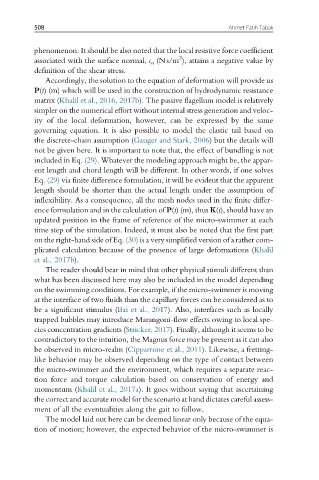Page 514 - Handbook of Biomechatronics
P. 514
508 Ahmet Fatih Tabak
phenomenon. It should be also noted that the local resistive force coefficient
2
associated with the surface normal, c n (Ns/m ), attains a negative value by
definition of the shear stress.
Accordingly, the solution to the equation of deformation will provide us
P(t) (m) which will be used in the construction of hydrodynamic resistance
matrix (Khalil et al., 2016, 2017b). The passive flagellum model is relatively
simpler on the numerical effort without internal stress generation and veloc-
ity of the local deformation, however, can be expressed by the same
governing equation. It is also possible to model the elastic tail based on
the discrete-chain assumption (Gauger and Stark, 2006) but the details will
not be given here. It is important to note that, the effect of bundling is not
included in Eq. (29). Whatever the modeling approach might be, the appar-
ent length and chord length will be different. In other words, if one solves
Eq. (29) via finite difference formulation, it will be evident that the apparent
length should be shorter than the actual length under the assumption of
inflexibility. As a consequence, all the mesh nodes used in the finite differ-
ence formulation and in the calculation of P(t) (m), thus K(t), should have an
updated position in the frame of reference of the micro-swimmer at each
time step of the simulation. Indeed, it must also be noted that the first part
on the right-hand side of Eq. (30) is a very simplified version of a rather com-
plicated calculation because of the presence of large deformations (Khalil
et al., 2017b).
The reader should bear in mind that other physical stimuli different than
what has been discussed here may also be included in the model depending
on the swimming conditions. For example, if the micro-swimmer is moving
at the interface of two fluids than the capillary forces can be considered as to
be a significant stimulus (Bai et al., 2017). Also, interfaces such as locally
trapped bubbles may introduce Marangoni-flow effects owing to local spe-
cies concentration gradients (Stricker, 2017). Finally, although it seems to be
contradictory to the intuition, the Magnus force may be present as it can also
be observed in micro-realm (Cipparrone et al., 2011). Likewise, a fretting-
like behavior may be observed depending on the type of contact between
the micro-swimmer and the environment, which requires a separate reac-
tion force and torque calculation based on conservation of energy and
momentum (Khalil et al., 2017a). It goes without saying that ascertaining
the correct and accurate model for the scenario at hand dictates careful assess-
ment of all the eventualities along the gait to follow.
The model laid out here can be deemed linear only because of the equa-
tion of motion; however, the expected behavior of the micro-swimmer is

